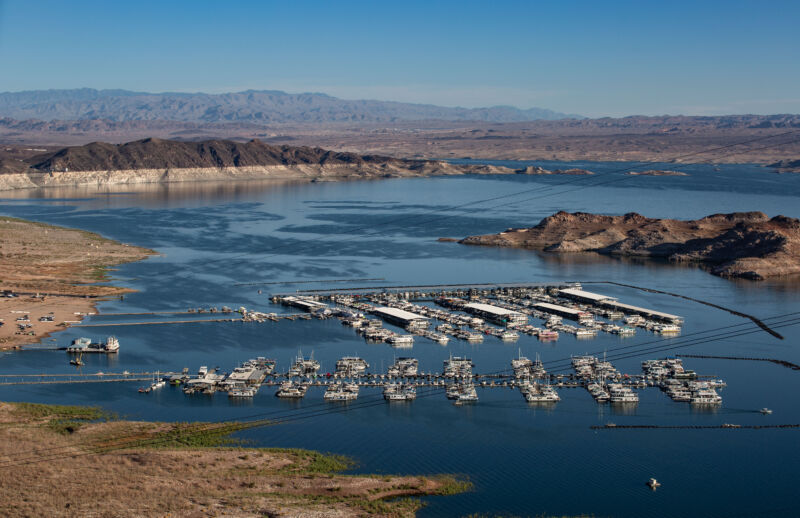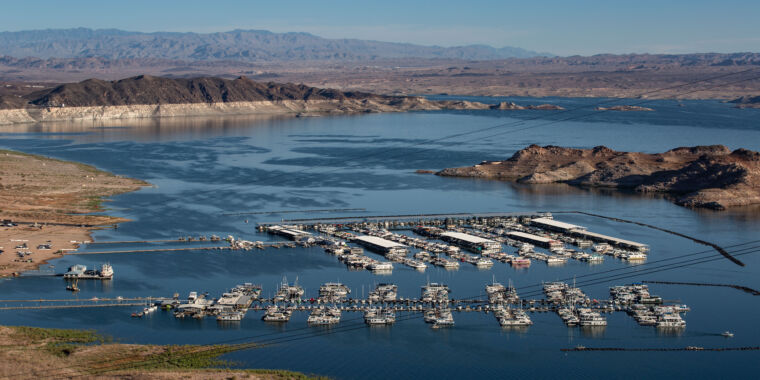
It’s been one of the wettest years in California since records began. From October 2022 to March 2023, the state was blasted by 31 atmospheric rivers—colossal bands of water vapor that form above the Pacific and become firehoses when they reach the West Coast. What surprised climate scientists wasn’t the number of storms, but their strength and rat-a-tat frequency. The downpours shocked a water system that had just experienced the driest three years in recorded state history, causing floods, mass evacuations, and at least 22 deaths.
Swinging between wet and dry extremes is typical for California, but last winter’s rain, potentially intensified by climate change, was almost unmanageable. Add to that the arrival of El Niño, and more extreme weather looks likely for the state. This is going to make life very difficult for the dam operators tasked with capturing and controlling much of the state’s water.

Like most of the world’s 58,700 large dams, those in California were built for yesterday’s more stable climate patterns. But as climate change taxes the world’s water systems—affecting rainfall, snowmelt, and evaporation—it’s getting tough to predict how much water gets to a dam, and when. Dams are increasingly either water-starved, unable to maintain supplies of power and water for their communities, or overwhelmed and forced to release more water than desired—risking flooding downstream.
But at one major dam in Northern California, operators have been demonstrating how to not just weather these erratic and intense storms, but capitalize on them. Management crews at New Bullards Bar, built in 1970, entered last winter armed with new forecasting tools that gave unprecedented insight into the size and strength of the coming storms—allowing them to strategize how to handle the rain.
First, they let the rains refill their reservoir, a typical move after a long drought. Then, as more storms formed at sea, they made the tough choice to release some of this precious hoard through their hydropower turbines, confident that more rain was coming. “I felt a little nervous at first,” says John James, director of resource planning at Yuba Water Agency in Northern California. Fresh showers soon validated the move. New Bullards Bar ended winter with plumped water supplies, a 150 percent boost in power generation, and a clean safety record. The strategy offers a glimpse of how better forecasting can allow hydropower to adapt to the climate change.
Modeling studies have long suggested that better weather forecasts would be invaluable for dam managers. Now this is being confirmed in real life. New Bullards Bar is one of a half-dozen pilot sites teaming up with the US Army Corps of Engineers to test how cutting-edge forecasting can be used to optimize operations in the real world. Early tests of the methods, called forecast-informed reservoir operations, have given operators the confidence to hold 5-20 percent reserve margins beyond their reservoirs’ typical capacity, says Cary Talbot, who heads the initiative for the Army Corps.
To Talbot, FIRO could mean a paradigm shift in how the Corps and others run dams. Historically, dam operators under the Army Corps umbrella had to ignore weather forecasts and respond only to rain and snow that was already on the ground. This rule traces back to the notorious capriciousness of traditional forecasts: If an operator takes a bad gamble on a forecasted weather event, the results can be dangerous. But in practice, this forces operators to react later than their gut tells them to, says Riley Post, a University of Iowa researcher who spent over a decade as a hydraulic engineer for the Corps. They might, for example, be expected to hold water in a nearly full reservoir even as heavy rains approach.
Recent developments, however, have sharpened the trustworthiness of forecasts, particularly for atmospheric rivers on the West Coast. Leaps in computing power have enabled ever-more-muscular climate and weather modeling. To pump these models with data, scientists led by the Scripps Institution of Oceanography have since 2016 launched reconnaissance flights over atmospheric rivers of interest, where they release dozens of dropsondes, sensor packs shaped like Pringles cans. The result is a detailed profile of a storm’s strength, size, and intentions, which can then feed into FIRO.
These reports aren’t clairvoyant; all weather forecasts involve a measure of uncertainty. But a dam operator with increased confidence in when, where, and how much water will strike their watershed can take a more “surgical” approach to holding or releasing water, Post says.
And if they know how much time they have, they can also make the most of their existing water. Take Prado Dam, a vintage 1941 facility that was built to shield Orange County from flooding but can also distribute water to 25 groundwater-recharge stations. This past winter, forecasts showed a well-spaced parade of storms tracking its way. So operators pulsed water from the dam into storage at an optimal cadence, giving it time to soak into the landscape. Adam Hutchinson of the Orange County Water District, which manages the groundwater-recharge system, said publicly in July that these actions delivered an “exceptional” boost to water supplies for “those dry years we know are coming.”

